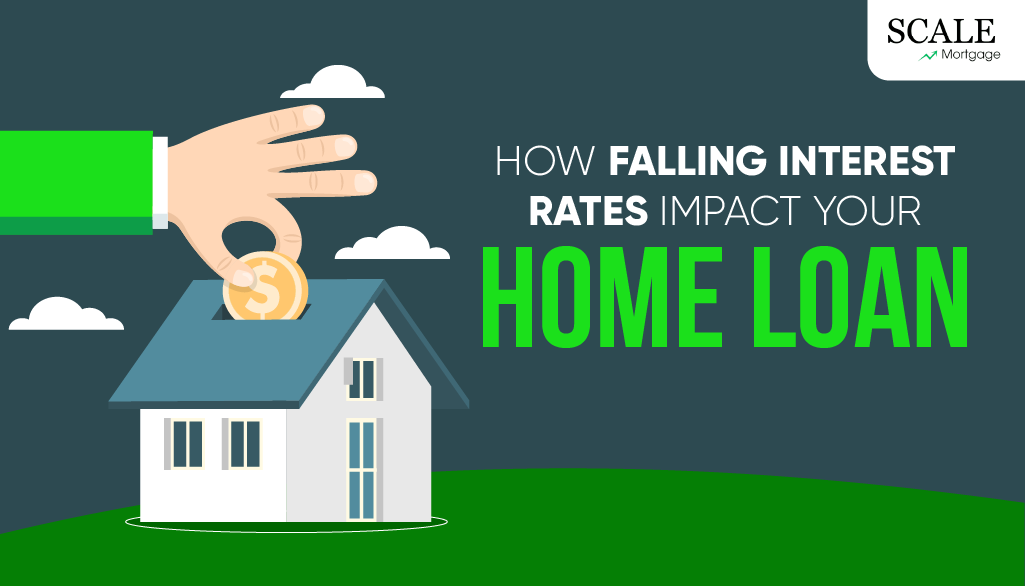How Falling Interest Rates Impact Your Home Loan
With the expectation of falling interest rates in Australia, it is important to understand its intricate effect on home loan decisions.
Estimated reading time: 6 minutes
Author:
Share:

For existing homeowners, knowing the impact of falling interest rates can help assess the potential benefits of refinancing to secure a lower rate or more favourable loan terms. Prospective homeowners, on the other hand, can anticipate RBA interest rate decisions and take informed action on their home loans.
Factors Influencing Interest Rate Movements
Interest rates are influenced by domestic economic conditions, global factors, and central bank policies.
- Inflation
When there’s high inflation, the general level of prices for products and services rapidly rises. Authorities may raise interest rates so people will spend less and keep prices from rising too fast. Fewer spending lowers the demand for goods and services, which consequently puts downward pressure on prices.
On the flip side, when inflation is low, interest rates may be lowered to encourage more borrowing and spending to stimulate economic activity.
Elevated interest rates for a long period can impede economic growth, especially during times of economic downturn or when there are concerns about deflation. Reducing interest rates can help ease financial conditions and support borrowing and spending, which are essential drivers of economic activity.
- Central Monetary Policy
The Reserve Bank of Australia (RBA) implements the monetary policy in Australia.
When the RBA changes the cash rate – the interest rate at which financial institutions borrow funds from other banks in the money market, commercial banks typically adjust their interest rates to align with the RBA cash rate.
When the RBA increases the cash rate, a bank’s borrowing cost becomes more expensive. Commercial banks often compensate for the higher costs by raising interest rates on the mortgages and personal loans they offer to the public.
Conversely, when the RBA decreases the official cash rate, borrowing becomes cheaper for banks, enabling them to lower interest rates on loans.
Why Is There An Expectation of Lower Interest Rates in Australia?
Following a period of rising global inflation and successive rate hikes by the Reserve Bank of Australia (RBA) in 2022 and early 2023, there have been predictions of potential rate cuts in 2024. This expectation is driven by the cooling of inflationary pressures and the need to support economic growth amidst uncertain global conditions.
Elevated interest rates for a long period can impede economic growth, especially during times of economic downturn or when there are concerns about deflation. Reducing interest rates can help ease financial conditions and support borrowing and spending, which are essential drivers of economic activity.
What Are The Predictions For RBA Interest Rates In 2024?
RBA interest rate forecast in 2024 suggests that rate cuts are on the horizon. Major banks like ANZ and Commonwealth Bank predict reductions by late in the year.
- ANZ economists anticipate the first rate cuts around November, with rates dropping to 4.10% initially and further decreasing to approximately 3.60% by mid-2025.
- Commonwealth Bank expects a reduction around September, with rates eventually reaching around 2.85% by mid-2025.
As lenders respond to a perceived slowdown in rate tightening, many have already begun cutting fixed and variable rates, indicating a potential shift away from peak mortgage rates.
Impact of Falling Interest Rates on Home Loans
Considering movements in interest rates is important in navigating home loan options. Whether you choose a fixed or adjustable-rate mortgage, fluctuations in interest rates influence the affordability of your down payments, monthly repayments, and closing costs.
Lower Monthly Payments
Low-interest rates can be advantageous for financing a home, but the extent of their benefit depends on the type of mortgage you hold.
Conversely, falling interest rates lead to immediate savings in monthly payments for borrowers with variable home loan rates. This is because the interest rate on a variable-rate mortgage is tied to a benchmark rate (e.g., RBA cash rate) and adjusts periodically in response to changes in prevailing rates.
Refinancing Opportunities
Refinancing provides homeowners with the flexibility to better align their mortgage terms with their current financial situation and long-term goals. For example, homeowners with variable-rate mortgages may explore refinancing options to secure a fixed-rate home loan at a lower rate and safeguard their loans from potential future rate increases.
However, borrowers should be aware of the caveats of refinancing home loans:
- Closing Costs: Refinancing typically involves upfront costs such as appraisal fees, application fees, and closing costs, which can add up to thousands of dollars.
- Equity Requirements: Lenders may require a certain amount of equity in the home to qualify for refinancing.
- Prepayment Penalties: Some mortgage contracts impose fees for paying off the loan early through refinancing.
Increased Affordability
When interest rates decrease, monthly mortgage payments also decrease, making it more affordable for individuals to qualify for and afford a home loan. This reduction in borrowing costs can broaden the pool of eligible buyers, allowing more people to enter the housing market.
Lower rates may also enable buyers to qualify for larger loan amounts, giving them the ability to consider a wider range of properties. Falling interest rates can make homeownership more attainable for individuals or families seeking to buy their own home.
Easier Mortgage Approval
Because reduced interest rates would result in lower total mortgage costs, borrowers may find it easier to qualify for a new home loan. That’s because a lower payment decreases your debt-to-income ratio (DTI), which is a major factor home lenders consider when qualifying you for a new mortgage. Your DTI is the percentage of your monthly obligations compared to your gross monthly income.
Take Proactive Mortgage Planning With Scale Mortgage
Knowing the impact of falling interest rates on your home loan empowers you to make informed financial decisions. By understanding how rate movements impact your home loan, you can make informed decisions to optimise your mortgage and achieve your financial goals.
As you navigate the impact of falling interest rates on your home loan, it’s essential to adopt a proactive approach to financial planning. Consider consulting with a mortgage advisor or broker to assess your options and develop a strategy that aligns with your objectives.
Unlock your potential savings and financial opportunities with Scale Mortgage, your trusted mortgage broker in Australia. Whether you’re considering refinancing, purchasing a new home, or navigating rate fluctuations, our expert team is here to guide you every step of the way.
Contact us today to explore personalised mortgage solutions tailored to your needs and seize the best rates in the market.


External Resources


Thomas Makin
Thomas Makin is the Principal Mortgage Broker and Co-Founder of Scale Mortgage. He has a Diploma in Finance and Mortgage Broking Management and is accredited by the Mortgage & Finance Association of Australia (MFAA).
Thomas is known for his skill in providing tailored mortgage solutions. He helps homebuyers and investors across Australia, showing a strong commitment to professionalism and high industry standards.



